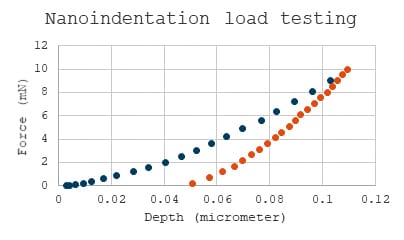Application note
Automated nanoindention and its role in data-driven materials research
By Krisztián Bali, Tamás Tarjányi, Kun Wang, and Xingwu Wang
Machine learning has the potential to revolutionize the discovery and development process of novel materials.1 However, to properly train these models, researchers must have access to massive amounts of experimental data.
Automated systems provide a way to collect and process high-quality data at record speeds by reducing the need for manual operation and oversight. Recently, researchers at Alfred University in New York had the opportunity to explore the benefits of automated experimentation when Semilab (Budapest, Hungary) loaned the university its new IND-1500 nanoindentation system (Figure 1) in October 2023.
bulletin | feature

Figure 1. The Semilab IND-1500 nanoindentation system at Alfred University. The nanoindenter is placed within an enclosed chamber on top of a vibration isolation air cushion to prevent environmental factors from affecting the experiment.
Credit: Tony Augustine, Alfred University

Figure 1. The Semilab IND-1500 nanoindentation system at Alfred University. The nanoindenter is placed within an enclosed chamber on top of a vibration isolation air cushion to prevent environmental factors from affecting the experiment.
Credit: Tony Augustine, Alfred University
This system is the next generation of Semilab’s basic IND-1000 tabletop nanoindentation system. Like its predecessor, the IND-1500 nanoindenter can collect and process data without constant oversight by a human operator. But it has several new user-friendly features, including a simplified user input interface, consolidated electrical feeds, and, notably, a vibration isolation air cushion.
These features reduce the impact of environmental factors on the data collection process, such as mechanical vibrations from nearby roadways, and thus improve the noise-to-signal ratio in the collected data. As a result, data on a material’s mechanical properties can be automatically collected and processed with 99% accuracy.
Prior to the loan of the IND-1500 system, Alfred researchers relied on a manual nanoindentation system that did not feature any automation. With the new system, they simply input an estimated Poisson ratio and the machine then generated large datasets for a wide variety of materials, including ceramics, metals, and layered semiconductors, in just a few hours.2,3

Figure 2. Graph of the load displacement curve for a nanoindented transition metal diboride.2
Blue dots: elastic–plastic loading curve. Orange dots: elastic unloading curve.
Credit: Bryan Zaremba and Kun Wang
As an example of the system’s capabilities, the researchers nanoindented a transition metal diboride sample (Figure 2), which has intended uses in various extreme environmental conditions, such as mechanical abrasion, ultrahigh temperatures, high pressures, and severe chemical attacks. Based on a 5 mm x 5 mm x 1 mm sample, the IND-1500 nanoindentation system generated 200 data points in five minutes. In comparison, when similar experiments were performed on the original manual nanoindentation system, it took 10 times as long to collect this amount of data.
Ultimately, this experience with the IND-1500 nanoindentation system demonstrates the importance of automated systems in realizing the benefits and potential of data-driven materials research in both academic and industrial settings.
Acknowledgments:
We sincerely thank the following personnel from Alfred University for their valuable contributions and help: Jim Thiebaud, Bryan Zaremba, S. K. Sundaram, Nathan Sponenberg, John Simmins, and David Gottfried. Thanks also to Semilab personnel John Byrnes and Gergo Meszaros for loaning the equipment and their technical guidance.
About the authors:
Krisztián Bali and Tamás Tarjányi are applications scientists and service engineers at Semilab (Budapest, Hungary). Kun Wang is assistant professor of materials science and engineering and Xingwu Wang is professor of electrical engineering at Alfred University in New York. Contact Xingwu Wang.